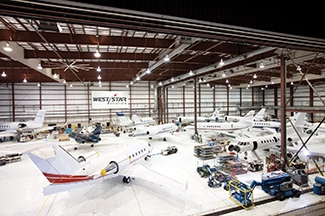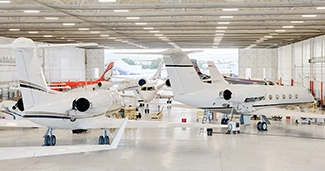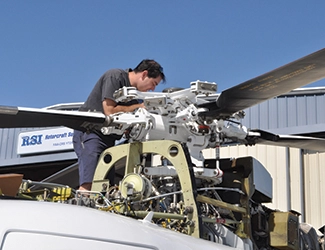Independent MRO providers performing work covered by OEMs.
By Owen Davies
Contributing writer
Our first look at the role of MROs in bizjet warranty programs (Pro Pilot, July 2023, p 8) showed us that there was much left to learn. Revisiting the subject has revealed that involvement with OEMs varies widely among independent maintenance organizations. We found some MROs that hardly deal with hourly-cost maintenance programs (HCMPs). Mostly, they see aircraft that are too old for coverage to make sense to operators. Others do almost nothing but maintenance and repairs charged to OEM programs.
Overall, independent MRO companies deliver most of the work now covered by the maintenance contracts offered by most bizjet makers.
MROs did have one issue in common – they suffer a growing shortage of trained A&P mechanics. Most already are scrambling to fill the gap between needs and supply. Others see a crunch coming and are not sure how to handle it. Operators are likely to find maintenance costs and lead times growing in the years ahead.
Here is a look at some MROs with interesting stories to tell.

Banyan Air Service
Banyan is not your typical FBO/MRO. Based at FXE (Exec, Fort Lauderdale FL), it has 1,000,000 sq ft of hangar space and reported revenues of nearly $218 million in 2023.
If it’s a fixed–wing business aircraft, Banyan probably has experience with it. The company defines itself as a turbine maintenance service center that specializes in, but is not limited to, Bombardier Challenger, Global, and LearJet lines; and Cessna Citation, Dassault Falcon, Gulfstream, Hawker, HondaJet, King Air, and Pilatus aircraft.
Banyan has been working with OEM maintenance programs for more than 20 years. These include parts programs for Textron and Bombardier; parts and labor programs for Pilatus and HondaJet, for engines from Pratt & Whitney Canada (P&WC) and the GE Honda Aero Engines collaboration, for Rockwell Collins CASP avionics, and for Honeywell engines, avionics, and mechanical systems.
Charles Amento, VP/Director of MRO services, reports that OEM programs make up between 30% and 40% of the company’s MRO work. “Since Honda is so large now, it is a huge part of the daily process,” he notes. However, warranty inspections and maintenance make up only a small fraction of Banyan’s workload – less than 5%. Most of the aircraft Banyan sees have aged out of their warranties.
Amento reports that supply chain problems, which delayed some work even a year ago, are largely past. He continues, “Some parts still have to be planned for, but most are available right away. Some 90% of the time, there are no issues.”
So far, Banyan has had relatively little difficulty with the shortage of A&P mechanics and AV technicians that challenge other MROs. “We have a great retention rate,“ Amento reports. Nonetheless, the company has been hiring and training new technicians to minimize the impact as today’s workforce retires.

West Star Aviation
Based at ALN (St Louis Regional, East Alton IL), West Star Aviation operates 3 full-service MRO facilities and 6 satellite locations. Most are in the Midwest, but the chain stretches to Chattanooga TN and Denver and Grand Junction CO.
If business aircraft need work, West Star can probably handle it. The company is an authorized service center for Textron’s Citation and King Air lines and for Embraer business jets. It also has extensive experience with the Challenger, Falcon, Gulfstream, Global Express, Hawker, and Learjet aircraft.
In addition to carrying out routine engine inspections and repairs, West Star is authorized to support Honeywell’s MSP and MSP Gold programs, P&WC’s Eagle, Williams’ TAP and TAP Elite, and GE’s On Point programs. It also handles customer service for Sundstrand APUs, emergency power units, and other aerospace components.
In addition, the company is an FAA–certified Class I, II, and III avionics repair station.
“More than half our work falls into the category of maintenance, and nearly all of it would fall under the OEM Continuous Airworthiness Maintenance Program,” says West Star COO Allen McReynolds. “However, less than 10% is covered under an OEM warranty. “The bulk of our customer base are not flying brand-new aircraft,” he explains. “Many older aircraft are flying with second, third, and fourth owner/operators. They make up the largest part of our business.”
West Star has a large AOG business, so much of its work begins as unscheduled events. “Many of these jobs end up having scheduled maintenance tasks due before the unscheduled work is complete,” McReynolds notes.
The company has a unique answer to the manpower problem. It has just opened the West Star Academy, an FAA-approved Part 147 training facility. It can recruit young people in local communities and train them in the company’s way of doing things from the ground up. West Star even supplies their tooling, sparing them a tall barrier to entry for would-be A&P mechanics.
“We believe this will be a major component to our hiring pipeline for years to come,” says McReynolds.

Cutter Aviation
Based at PHX (Phoenix AZ), Cutter Aviation operates 6 FBOs in the Southwest, selling Pilatus and Piper turboprops at 6 locations, and providing MRO services at 5. All 5 are authorized service centers for various aircraft.
“We used to be a King Air service center,” says president Will Cutter. “Textron has taken that work in-house, but we still do a lot of work on older King Airs.”
However, about 70% of the company’s customers operate aircraft that are still under warranty. “Being the place that sells the aircraft, they automatically come to us for warranty work,” Cutter says. “Pilatus probably accounts for most of it.”
Aircraft sales have served the MRO operation well. “Last year was our best year ever,” Cutter reports. “The MRO operation did a little over $42 million in business.” He estimates that airframe maintenance accounts for about 60% of Cutter’s work. The rest is evenly divided between avionics and engine maintenance. “Jet engines don’t take a lot of maintenance,” he adds. Major work like hot sections and overhauls is sent back to the manufacturer.
The company keeps a large stock of parts on hand. “We keep in inventory any item of which we’ve sold 3 units in a year,” Cutter says. Yet, supply-chains remain a big problem for the company. “Windshields are a huge issue now,” he notes. “Delays can last for months. Thousands and thousands of parts are on back-order. Everything is running behind. The problem got better for a while. Then it got worse. Right now, it’s as bad as it ever was.”
This has a substantial impact on customers. Cutter can get an inspection done in a week or 10 days, but ordering necessary parts can mean a wait. “We won’t even start an installation until we have all the parts,” Cutter adds. “Customers push us to start earlier, but, with these delays, it doesn’t make sense.”
Cutter has even taken to 3D printing their own ducting for air conditioners, rather than ordering from the manufacturer. The company has STCs for air conditioners and a GPU.
The other problem is personnel. Cutter has it easier than many companies. Its FBOs offer a steady supply of young people who want to become pilots and technicians. Yet, Cutter hits all the job fairs and offers scholarships at Embry-Riddle. But not even this guarantees that new technicians will remain with the company. “We often get them trained, and they decide they’d prefer another line of work,” Cutter says. “We also lose people to the factory-owned service centers here.”

Clay Lacy Aviation
This respected FBO/MRO based at VNY (Van Nuys CA) may be best known for the fame of its founder – Clay Lacy, the 55,000-hour pilot who introduced aircraft management and charter services to the western US. However, the company also operates Part 145 repair stations in SNA (John Wayne, Santa Ana CA), BFI (Boeing Field, Seattle WA), and OXC (Oxford CT).
Its MROs are factory–authorized service centers for Embraer business jets, including the Legacy, Praetor, and Phenom lines. However, the company maintains and repairs planes from nearly all executive aircraft manufacturers. The list includes Bombardier, Dassault, Hawker, Eclipse, Pilatus PC-24 jet, and the PC-12 and King Air turboprops.
“We do a lot of Gulfstream work,” says Ed Mirzakhanian, senior vp, business operations. “We put in about 50,000 man-hours a year on Gulf-
streams that are anywhere from a year old to 96–month and 5000–hour inspections.” The company’s factory-trained technicians inspect, maintain, and repair Gulfstream models from the GIII and GIV to the G600 and G650 platforms.
About 85% of Clay Lacy’s work on Embraers is for the OEM continuing maintenance program. The rest is warranty work. OEM service programs also account for the large majority of the company‘s work on other business aircraft.
Clay Lacy also is an authorized service center for avionics from Honeywell, Collins, Garmin, and major aircraft Internet providers. About 10% of avionics revenue comes from OEM warranty and repair programs. The rest is installations.
Mirzakhanian reports that they have been feeling the worker shortage for a decade or more. It is particularly acute in southern California, where they used to have 6 or 7 A&P schools. They are now down to 2.
Clay Lacy partners with one local school, offering a sponsorship program and financial assistance to graduating classes. Unfortunately, the company can absorb only 1 or 2 green technicians per year. “About 45% of our volume is unscheduled events where green techs can’t keep up,” Mirzakhanian explains.
Rice Lake Air Center
Based at RPD (Rice Lake WI), Rice Lake Air Center (RLAC) looks at first glance like any other small-town FBO. It manages the airport, rents out airplanes, gives flight lessons. Look closer, however, and something less expected appears – for more than 30 years, RLAC has been an authorized Daher TBM service center. RLAC handles about 120 aircraft per year, drawing customers from as far away as France, Chile, and Mexico. They are booked up 18 months ahead.
If a TBM needs airframe work, RLAC can take care of it. The company even bought several aircraft to supply parts that cannot be ordered readily. If a TBM’s PT6A–64 or –66D engine needs inspection or repair, RLAC has it covered. If the 5–blade MT propeller needs maintenance, they can deal with that, too. Since 2011, they have been MT’s only authorized distributor of that propeller for the North American TBM community.
Roughly 80% of MRO work is charged to Daher’s maintenance program. “TBMs are not a high-time airplane yet,“ explains owner Joe Robbins. “A few have flown their 16,000 hours, but the ones we see are 4000- to 6000-hour aircraft that are still in good condition.”
TBM operators might bring RLAC a lot more work if the facility could handle it. It can’t and probably will never have the capacity. The company does not have the manpower, and Robbins has serious concerns finding personnel. “It takes 10, 15, even 20 years to get a mechanic trained up to the level we need, where they can look at any part of the airplane and know how it works and how to fix it,” he says.
Unlike many MROs, RLAC does not have an apprenticeship program. “I have tried that, and it doesn’t work for us,” says Robbins. “You get kids whose parents haven’t taught them to be responsible yet. Then, when you train them up to be adequate beginners and they get their license, they move on. Even the ones who have grown up here want to see other places.”

Rotorcraft Support
In Fillmore CA, Rotorcraft Support, Inc (RSI) is exactly what it says on the label – an MRO devoted to keeping all those moving parts flying in formation. It is an authorized service center for just about every helicopter manufacturer in the US and Europe. Bell, Leonardo, and MD aircraft account for most of RSI’s man-hours, but the company’s range extends to Airbus, Robinson, Enstrom, Schweitzer, and the Sikorsky S-76.
RSI also is an authorized service center for Rolls–Royce and Safran helicopter engines. In addition, it does some troubleshooting and repair of avionics, but most of their work consists of installing units sold to their customers.
“Much of our work is under OEM programs, but only 4% or less is under warranty,“ says VP Terri Neville. “Helicopters last forever, so most of the market is for maintaining older models. We do a lot of straightforward maintenance, but we also carry out component overhauls for Bell, Airbus, and MD. Although we are authorized for engine work, we send overhauls and other large jobs to companies that specialize in it. We also send rotors to a specialist.”
RSI avoids boom-and–bust markets like the military or oil and gas companies. Most of their work is for muni-
cipalities with law enforcement and/or fire-fighting units, or for private owners. “This is generally a stable market,” Neville reports, “although at the moment, federal grants for municipal services are creating a lot of extra jobs in completions.”
Workforce issues are an even bigger problem for RSI than for most MROs. “Technical schools are not an option for recruiting,“ Neville says. “They train almost exclusively for fixed-wing maintenance. It’s a very different field.”
The military used to provide trained helicopter mechanics, but no longer. According to Neville, these days the military teaches their technicians to do one thing to one component. Hiring their technicians is like hiring directly out of high school. Mostly, we are offering higher salaries and looking farther and farther from home.
However, RSI has hired 3 apprentice level trainees so far. “It takes from 12 to 18 months before they can work on anything independently,” Neville comments. “Training them is a major commitment for our experienced technicians.”
Conclusion
So it goes with MROs. Many have all the work they can handle. Some, like West Star Aviation and Banyan Air Service, are expanding as fast as they prudently can. Others are becoming constrained by manpower problems. Yet, it may not always be so. Some OEMs are pulling their work in-house where they can have better control over it, and it’s becoming very difficult to get authorization to be a service center these days.
But this trend does not worry Joe Robbins at Rice Lake. “All OEMs are close to their margins,” he notes. “Some of them are developing their own maintenance networks, but it’s a lot cheaper for them to use independent companies.” So far, he sees only good times ahead.
 Owen Davies is a veteran freelance writer specializing in technology. He has been a futurist at Forecasting International and TechCast Global.
Owen Davies is a veteran freelance writer specializing in technology. He has been a futurist at Forecasting International and TechCast Global.